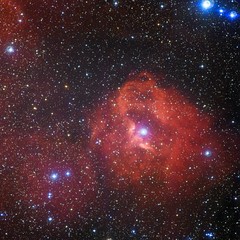Podcaster: Pamela Quevillon
Title: Space Scoop: Why You Couldn’t Hide Your Spaceship in a Nebula
Organization: Speak Easy Narration
Link : http://speakeasynarration.com ; http://unawe.org/kids/unawe1417/
Description: Space scoop, news for children.
Bio: Pamela Quevillon is a voice actress who most often lends her voice to science and science fiction content. You can find her work on the “Escape Pod” and “365 Days of Astronomy”, as well as on her site
Today’s sponsor: This episode of “365 Days of Astronomy” is sponsored by — no one. We still need sponsors for many days in 2013, so please consider sponsoring a day or two. Just click on the “Donate” button on the lower left side of this webpage, or contact us at signup@365daysofastronomy.org.
Transcript:
This is 365 Days of Astronomy. Today we bring you a new episode in our Space Scoop Series. This show is produced in collaboration with Universe Awareness, a program that strives to inspire every child with our wonderful cosmos.

Gem 41. Credit: ESO
This new space photograph reveals a cosmic cloud (or ‘nebula’) called Gum 41, which is made up of hydrogen, the most common gas in the Universe.
In the middle of this nebula are lots of brilliant, hot, young stars. The stars are shooting out high-energy light that is causing the surrounding hydrogen to glow this vivid scarlet colour.
Many of the most famous astronomical photographs are of colourful nebulas, like this one. In these pictures, the clouds appear to be thick and bright, but this is actually misleading.
If a human space traveller could fly a spaceship through Gum 41, they would probably not notice they were inside it at all! These clouds are spread so thinly that they are too faint for the human eye to see up close.
These clouds are like a very, very thin fog. From a few metres away, fog seems like a cloudy wall that you will walk in to. But, as you move closer the fog seems to disappear – it always seems to stay just out of reach. And these clouds are much less thick than fog!
This helps to explain why this large, bright cloud wasn’t discovered until 1951!
Cool Fact: You can’t always believe what you see on TV; Star Trek, Star Wars and BattleStar: Galactica have all shown spaceships hiding inside thick, gassy nebulas. But now you know better – these clouds offer no refuge at all for a spaceship trying to stay hidden!
365 Days of Astronomy is a community podcast made possible thanks to the contributions of people like you. Please consider donating at 365DaysofAstronomy.org/Donate
End of podcast:
365 Days of Astronomy
=====================
The 365 Days of Astronomy Podcast is produced by Astrosphere New Media. Audio post-production by Richard Drumm. Bandwidth donated by libsyn.com and wizzard media. You may reproduce and distribute this audio for non-commercial purposes. Please consider supporting the podcast with a few dollars (or Euros!). Visit us on the web at 365DaysOfAstronomy.org or email us at info@365DaysOfAstronomy.org. In the new year the 365 Days of Astronomy project will be something different than before….Until then…goodbye

